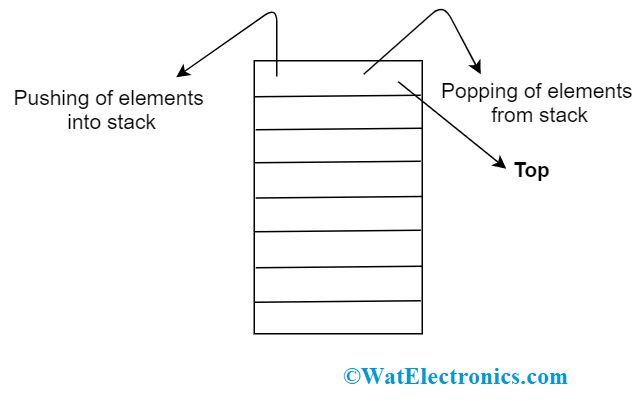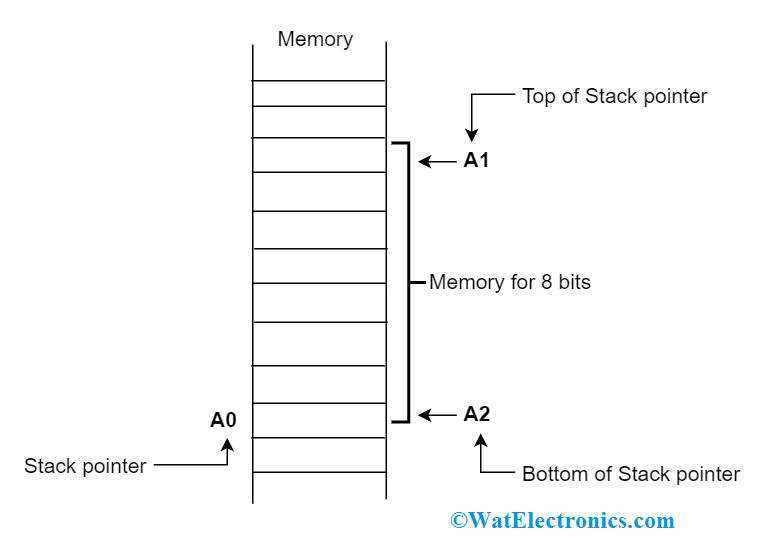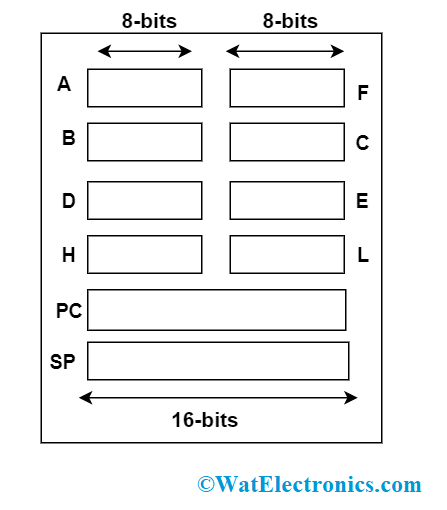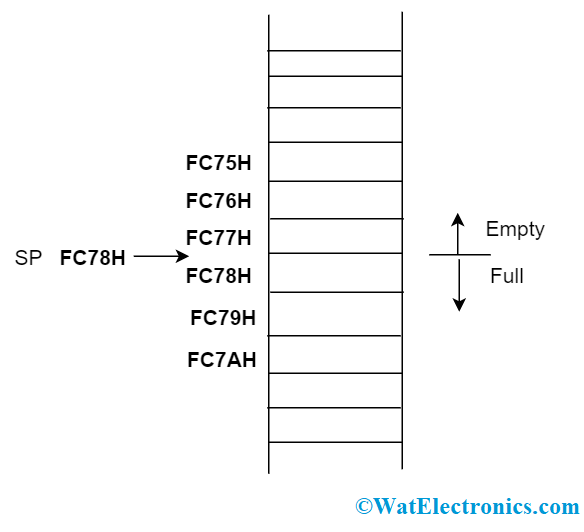Does Each Stack Frame Come With New Registers
The concept of stack came into limelight with the usage of terms "bury" and "unbury" where those corresponds to calling and returning from the subroutine functions. To be articulate in the concepts of Stack and Stack Pointer, initially, we need to sympathize the terms what is an"Array" and "Linked listing"? An assortment is divers as the randomly attainable data structure where one can easily access the elements in this and in steady time. Binary search is a clear instance of a random-admission data structure. While a linked listing is defined as the sequentially accessible data construction where every element in this has to exist accessed only in a specific order. A scroll of tape is a clear case of a sequential-access information structure.
So, we are clear about what a sequential access data structure is? Now, we move our discussion to the subcategory of sequential admission data structures and those are "Express access information structures". And Stack is the one that comes under limited access data structures. Allow's get into the detailed concepts backside Stack and Stack pointer.
What are the Stack and Stack Pointer?
A stack is stated as the container of elements where insertion and removal of the elements follow with the last-in-kickoff-out (LIFO) theory. Here, the insertion of elements is done through push button operation and removal of elements is done through a pop operation. Besides, the other definition in the technical aspect is, a stack is a LIFO data structure which is employed in the RAM expanse where one tin store temporary data and addresses when the microprocessor jumps to a subroutine from its current job. Then the retrieved accost would be used by the processor to spring dorsum to the previous routine/chore/task. A stack is also called a recursive data construction where pushing and popping happens continously.

stack basic functioning
Stack Pointer
It is the tiny register which stores the last program request's address in a stack. It is the particular kind of buffer that stores the information in the society of superlative-downward. When the new requests arrive, those will push down the previous requests. So, the latest request always is placed at the stack pinnacle position and the plan will get its requests only from the peak position. With the entry of new requests, the stack pointer moves ahead to the subsequent physical memory address and the latest element is replicated in the new address location. In the same way, when an element is removed from the stack, the SP falls back to the side by side present detail on the summit position in the stack.
In general, processors shop SPfsac in the hardware registers and the ALU (arithmetics and logic unit) functions to calculate its value. Commonly, push button and pop are converted as micro-operations to individually add in or remove the SP and deport out load and store in the memory.

sp basic performance
Stack Pointer in 8085
In the context of a programmer, an 8085 processor has merely A. B, C, D, Due east, H and Fifty, and the Flag registers. While in the complete view of 8085, information technology has the other two special purpose registers which are 16-bit each. Those are programme counter PC and the stack pointer SP. The purpose of SP in 8085 is to store the stack peak location address. While PC is the register that holds the memory location address and from here the adjacent executing pedagogy will exist retrieved. A view of 8085 with all the registers is shown below:

detailed view of the stack pointer
The stack pointer is a sixteen-bit register having a memory accost. For instance, when the SP contents are of FC78H, so the 8085 address locations are interpreted as beneath.
The memory locations FC78H, FC79H, FC80H……… FFFFH holds useful data and these memory locations are considered as filled locations. Whereas FC77H, FC76H….0000H does not have any information and those are considered empty locations. So, SP contents bespeak the uppermost locations in the stack which means that information technology specifies memory location having the smallest accost with useful data. It can be illustrated as:

stack pointer in 8085
How an SP Function?
The stack is generally a reversed expanse in RAM to store the information. Anywhere in the memory map, a stack tin be initialized, but ordinarily, information technology will be initialized at the higher memory location to go rid of any programming interface. Coming to 8085, the initialization of stack is instructed as
LXI SP, 16 flake
LXI SP is a sixteen-bit land which loads a 16-scrap address into stack annals. Before the utilization of stack, it has to be initialized to 1 higher value which is more than than the stack's highest memory location. The initialization of the stack pointer tin be done by Load Stack Pointer.
The stack in 8085 performs both Push button and POP operations. Both the operations piece of work together with annals pairs following the LIFO principle. Until the new data is inserted into the stack's memory location, the previous data volition not get obliterated.
Push Performance in a Stack is as Beneath
- The SP is decreased, and the higher-club annals pair contents (B in BC and D in DE) are replicated to the stack.
- Over again, the SP is decreased, and now lower order register pair contents are replicated to the stack. Here no flags or register pair contents will get modified.
For Example
When the instruction is PUSH D – It pushes the contents of DE. Suppose nosotros consider D = 15 H and E = 23 H. Let'southward assume that SP = 2300 H. And then the execution of PUSH P will result in the output as below:
| SP = 22 FE | Stack |
| 22 FE | 23 H |
| 22 FF | 15 H |
| 2300 |
Popular Operation in the Stack is as Beneath
- Stack's pinnacle location contents are replicated into stack lower annals (C in BC). And so SP gets increased by ane.
- And then the contents of stack location every bit shown by SP are replicated into stack's college register. Now, SP is increased by 1.
For Instance
Permit SP = 22FE H, the execution of POP H will result in the output as
| SP = 2300 | Stack |
| 22 Atomic number 26 | 10 H |
| 22 FF | 24 H |
| 2300 |
Here H = 24 H and L = 10 H
Use of Stack Pointer
The stack pointer is mainly used as a retentiveness pointer which specifies to the memory location that read and write retentiveness to that location.
- The typical usage of the stack arrow is to hold stack bits that belong to the nowadays function.
- It tin be used for both the user (as passed parameters and local variables) and CPU information (returning addresses at the time of subroutine call).
FAQ's
ane. What is the stack pointer in the ARM?
Equally the general usage of the stack is to agree automatic variables and parameters that are across office calls. In the context of ARM, the register SP R13 is utilized equally the arrow to the active stack.
two. Why stack arrow is of xvi-bit?
PC and SP are utilized to store the memory locations and as the previous location address is sixteen-bits and and then stack pointers are also of 16-bits. So that they hold a sixteen-scrap information address.
iii. What is the role of the stack pointer?
Following the principle of top-down, the stack pointer'south role is to store the last program request address. So, the arrival of new requests pushes downward the previous requests.
4. Which stack is used in 8085?
Stack in 8085 follows the LIFO stack where the terminal stored data will be received initially.
5. Is stack arrow a register?
Yeah, the stack pointer is a tiny annals that stores the terminal program asking address.
So, the concepts of Stack and Stack Pointer are every bit disccussed in a higher place and almost every programming application needs to implement the operation of these. Know more concepts on what are their implementations and other applications?
Does Each Stack Frame Come With New Registers,
Source: https://www.watelectronics.com/why-stack-and-stack-pointer-matters-the-most/
Posted by: moralesoure1974.blogspot.com


0 Response to "Does Each Stack Frame Come With New Registers"
Post a Comment